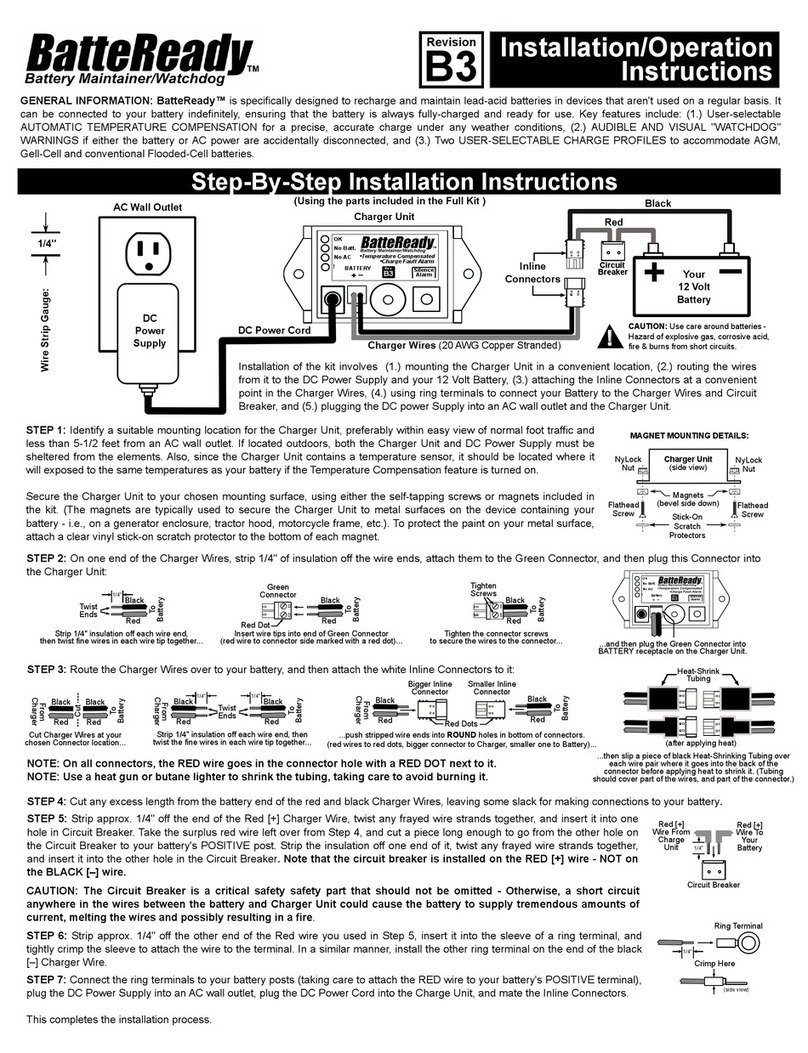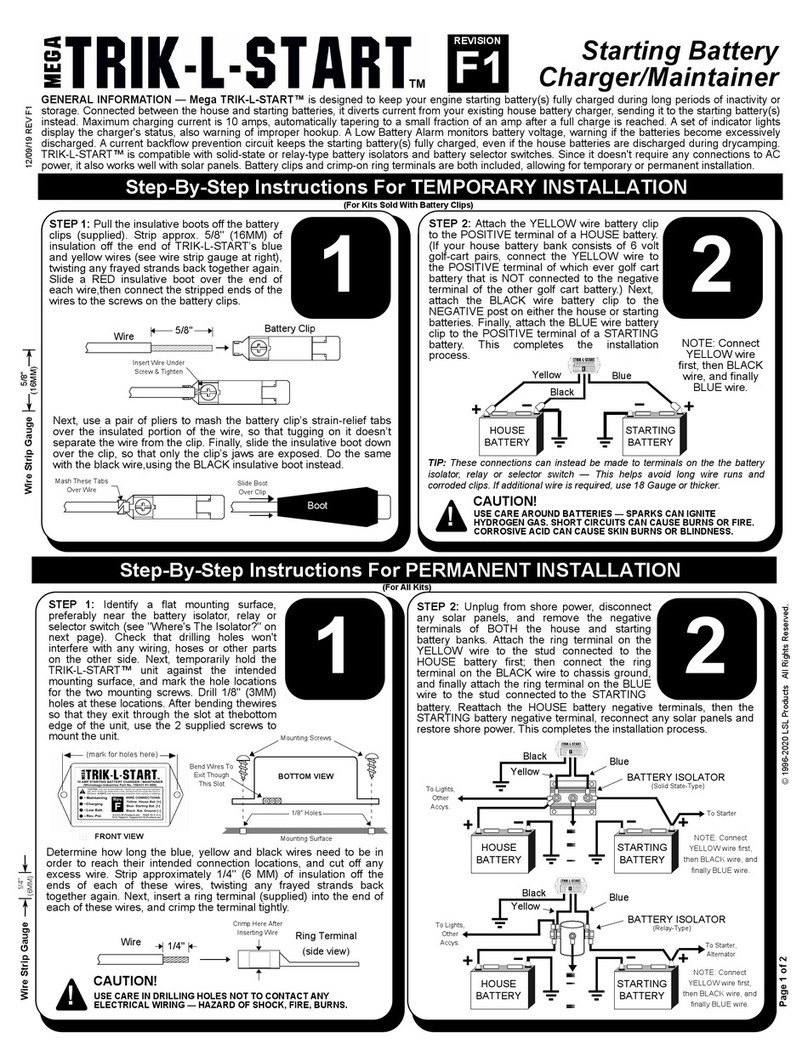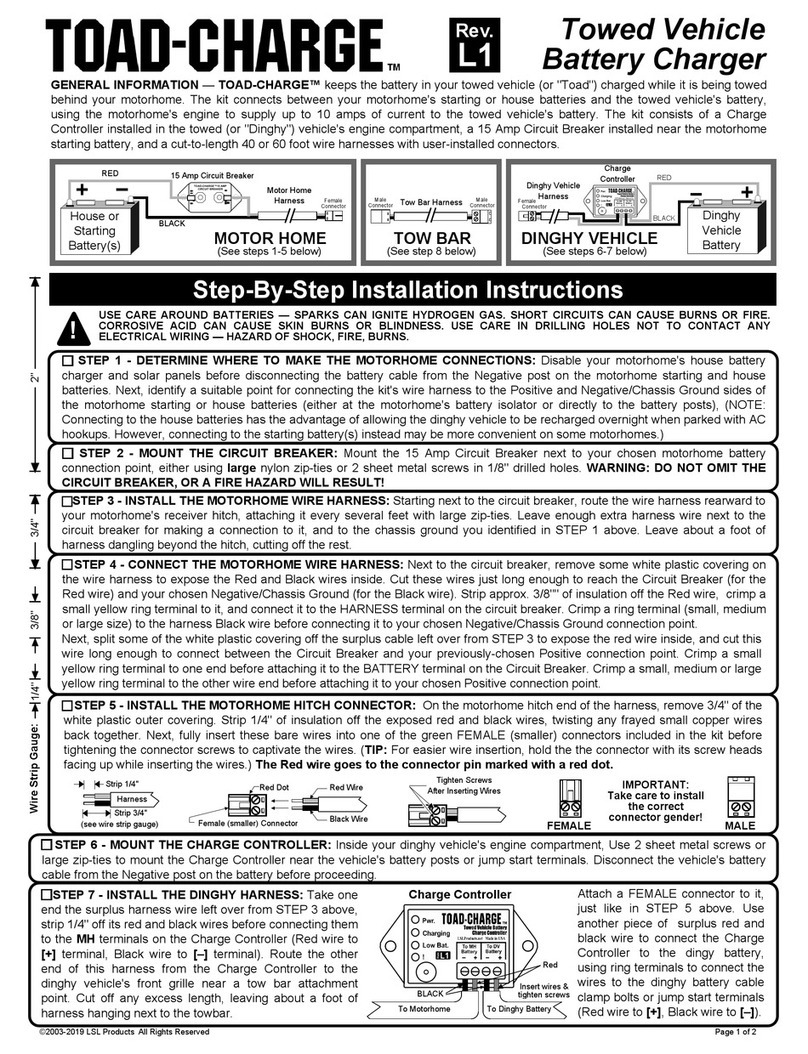
Towed Vehicle
Battery Charger
STEP 1 - DETERMINE WHERE TO MAKE THE MOTORHOME CONNECTIONS: Disable your motorhome's house battery
charger and solar panels before disconnecting the battery cable from the Negative post on the motorhome starting and house
batteries. Next, identify a suitable point for connecting the kit's wire harness to the Positive and Negative/Chassis Ground sides of
the motorhome starting or house batteries (either at the motorhome's battery isolator or directly to the battery posts), (NOTE:
Connecting to the house batteries has the advantage of allowing the dinghy vehicle to be recharged overnight when parked with AC
hookups. However, connecting to the starting battery(s) instead may be more convenient on some motorhomes.)
GENERAL INFORMATION — TOAD-CHARGE™ keeps the battery in your towed vehicle (or "Toad") charged while it is being towed
behind your motorhome. The kit connects between your motorhome's starting or house batteries and the towed vehicle's battery,
using the motorhome's engine to supply up to 10 amps of current to the towed vehicle's battery. The kit consists of a Charge
Controller installed in the towed (or "Dinghy") vehicle's engine compartment, a 15 Amp Circuit Breaker installed near the motorhome
starting battery, and a cut-to-length 40 or 60 foot wire harnesses with user-installed connectors.
Step-By-Step Installation Instructions
USE CARE AROUND BATTERIES — SPARKS CAN IGNITE HYDROGEN GAS. SHORT CIRCUITS CAN CAUSE BURNS OR FIRE.
CORROSIVE ACID CAN CAUSE SKIN BURNS OR BLINDNESS. USE CARE IN DRILLING HOLES NOT TO CONTACT ANY
ELECTRICAL WIRING — HAZARD OF SHOCK, FIRE, BURNS.
STEP 2 - MOUNT THE CIRCUIT BREAKER: Mount the 15 Amp Circuit Breaker next to your chosen motorhome battery
connection point, either using large nylon zip-ties or 2 sheet metal screws in 1/8" drilled holes. WARNING: DO NOT OMIT THE
CIRCUIT BREAKER, OR A FIRE HAZARD WILL RESULT!
©2003-2014 LSL Products All Rights Reserved
Next, split some of the white plastic covering off the surplus cable left over from STEP 3 to expose the red wire inside, and cut this
wire long enough to connect between the Circuit Breaker and your previously-chosen Positive connection point. Crimp a small
yellow ring terminal to one end before attaching it to the BATTERY terminal on the Circuit Breaker. Crimp a small, medium or large
yellow ring terminal to the other wire end before attaching it to your chosen Positive connection point.
STEP 4 - CONNECT THE MOTORHOME WIRE HARNESS: Next to the circuit breaker, remove some white plastic covering on
the wire harness to expose the Red and Black wires inside. Cut these wires just long enough to reach the Circuit Breaker (for the
Red wire) and your chosen Negative/Chassis Ground (for the Black wire). Strip approx. 3/8"" of insulation off the Red wire, crimp a
small yellow ring terminal to it, and connect it to the HARNESS terminal on the circuit breaker. Crimp a ring terminal (small, medium
or large size) to the harness Black wire before connecting it to your chosen Negative/Chassis Ground connection point.
STEP 6 - MOUNT THE CHARGE CONTROLLER: Inside your dinghy vehicle's engine compartment, Use 2 sheet metal screws or
large zip-ties to mount the Charge Controller near the vehicle's battery posts or jump start terminals. Disconnect the vehicle's battery
cable from the Negative post on the battery before proceeding.
House or
Starting
Battery(s)
TOAD-CHARGE™15 AMP
CIRCUIT BREAKER
STEP 7 - INSTALL THE DINGHY HARNESS: Take one
end the surplus harness wire left over from STEP 3 above,
strip 1/4" off its red and black wires before connecting them
to the MH terminals on the Charge Controller (Red wire to
MH+ terminal, Black wire to
MH–
terminal). Route the other
end of this harness from the Charge Controller to the
dinghy vehicle's front grille near a tow bar attachment
point. Cut off any excess length, leaving about a foot of
harness hanging next to the towbar.
STEP 5 - INSTALL THE MOTORHOME HITCH CONNECTOR: On the motorhome hitch end of the harness, remove 3/4" of the
white plastic outer covering. Strip 1/4" of insulation off the exposed red and black wires, twisting any frayed small copper wires
back together. Next, fully insert these bare wires into one of the green FEMALE (smaller) connectors included in the kit before
tightening the connector screws to captivate the wires. (TIP: For easier wire insertion, hold the the connector with its screw heads
facing up while inserting the wires.) The Red wire goes to the connector pin marked with a red dot.
STEP 3 - INSTALL THE MOTORHOME WIRE HARNESS: Starting next to the circuit breaker, route the wire harness rearward to
your motorhome's receiver hitch, attaching it every several feet with large zip-ties. Leave enough extra harness wire next to the
circuit breaker for making a connection to it, and to the chassis ground you identified in STEP 1 above. Leave about a foot of
harness dangling beyond the hitch, cutting off the rest.
Insert wires & tighten screws
(installed in dinghy vehicle)
Attach a FEMALE connector to it,
just like in STEP 5 above. Use
another piece of surplus red and
black wire to connect the Charge
Controller to the dingy battery,
using ring terminals to connect the
wires to the dinghy battery cable
clamp bolts or jump start terminals
(Red wire to +, Black wire to –).
Female (smaller) Connector
Tighten Screws
After Inserting Wires
IMPORTANT:
Take care to install
the correct
connector gender!

























